Top 10 Healthy Heuchera
In the gardener’s world there are two mortal enemies – deer and disease. Or at least they are mine – if I ignore my parsnip-munching voles, Amazon-sized mosquitoes and steroidal slugs.
When my show stopping Heuchera (coral bells) were cut down in their prime by rust, a fungal infection, it was almost enough to make me hang up my trowel. Rust causes nasty raised, purple bumps on the undersides of the leaves which spreads rapidly and can quickly destroy the plant. Although not seen in drier parts of the country it is a major problem here in the Pacific Northwest.
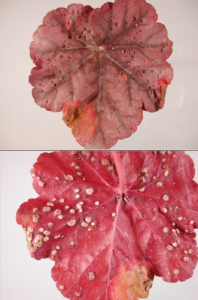
Rust can be detected by raised pustules on the undersides of the leaves and sunken areas above. Photo credit; Maryna Sedani, PNW Plant Disease Management Handbook
Having tossed far too many of these pricey treasures into the yard waste (NEVER compost diseased plants) I asked Dan Heims, president of Terra Nova Nurseries, Inc. for some ideas on what I could do to save those that I have and ask about the new disease resistant hybrids his nursery is breeding.
As a breeding company, Terra Nova Nurseries, Inc. is the leading innovator for new Heuchera and Heucherella introductions. It can take seven years of breeding and another three of testing to have a breakthrough but that dedication is what ensures that their plants are strong and healthy.
So what exactly is rust and what can we do to prevent it?
It is a fungal disease that usually travels on the plant itself or is airborne. In our soggy Seattle climate we provide the perfect conditions for it to thrive so the key to control is managing the environment.
Dan’s tips for healthy Heuchera
- Water in the early morning so foliage can dry
- Use drip irrigation rather than overhead sprinklers
- Space plants so as to allow for good air circulation
- Do not plant new Heuchera where diseased ones have been grown
- Remove diseased Heuchera immediately and dispose of in the yard waste (do not compost)
- The organic fungicide ‘Serenade’ may help prevent rust. (My personal experience has been that if you cut a mildly infected plant down hard and spray every two weeks (or as allowed on the label) until it is fully re-grown you have a reasonable chance of success; I may have been too hasty in disposing of a few).
Why are some Heuchera more susceptible than others?
The key word here is genetics or “it’s all the parents fault”. Now I did ask Dan to elaborate and share which species he was focusing on as showing the most promising disease resistant traits. His answer?
“I could tell you, but I'd have to kill you…Nothing personal… ”
Great.
What he was able to tell me was that the breeders noticed that the lighter colored Heuchera were particularly susceptible, so they were selecting for thicker leaves. They were also committed to evaluating potential introductions under multiple conditions over many years and anything that showed signs of rust was eliminated. In other words he wasn’t giving much away but that’s OK, especially when you read about some of these success stories.
Breeder’s top 5 (or 6, or 10)
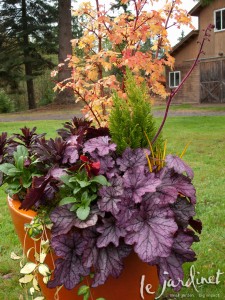
Spellbound lives up to my expectations with truly captivating foliage year round. Photo and design credit; Le jardinet
Spellbound – you've heard me salivate over this beauty before. Shimmery shades of purple and silver on impossibly oversized leaves. Mine looks as magical now as it did in fall and has made a loose mound approx. 18” across. Fabulous in my orange container!
Blondie – this one is on my wish list for sure. Part of the ‘Little Cutie’ series, Blondie is just 8” wide but is a flowering powerhouse pushing out oodles of creamy-yellow spikes. Foliage color is in the caramel family. A good choice for containers
Sugar Berry – from hot raspberry to deepest blackberry, this one is positively delicious. Also part of the Little Cutie series this tops out at 6” tall and 10” wide with short, fat spikes of white flowers
Fireworks – ruffled bronze foliage on a mid-sized plant with plenty of soft colored flowers
Mahogany – this promises to be a good alternative to my beloved ‘Peach Flambé’ which succumbed to both deer AND disease last year! The foliage looks like burnished copper-colored leather and transitions through shades of red and orange as the season progresses. I’d love to see this with some bright lime green
Paris – another one that is high on my wish list, I love the silver veining on this green foliage and those hot pink flowers are just plain FUN. A mid-sized, compact plant at 14” wide.
Other favorites; Obsidian, Sugar Plum, Root Beer, Ebony and Ivory.
All are hardy in zones 4-9, evergreen and do best if allowed to dry slightly between watering. Hummingbirds love them!
Where can we buy them?
They are widely available at both nurseries and online retailers; Terra Nova Nurseries, Inc. has provided these links to help you find your favorites.
What can we look forward to in the future?
Terra Nova Nurseries, Inc. is breeding some fabulous new Heucherella (foamy bells) which are rust resistant (yes you did read that correctly; all Heucherella are rust resistant for reasons which they undoubtedly know but will once again put my life in jeopardy if I ask) as well as continuing their Heuchera breeding program selecting plants which are healthy, have great foliage color and are vigorous.
They also have an exciting collection of heat-tolerant Heuchera , seeking out those with H. villosa in their parentage (apparently I was allowed to know that tidbit without death threats). Look for those with Southern sounding names as a clue e.g. Midnight Bayou, Southern Comfort and Georgia Peach.
And finally…
Be sure to check out their website at www.terranovanurseries.com to get more tips and ideas as well as to drool over their luscious photographs.
And of course you are invited to ‘like’ their Facebook page
In the absence of a LOVE button, like will have to do.
My sincere thanks to Dan Heims (aka Mr. Heuchera) and the Terra Nova Breeding Team for finding time to answer my barrage of questions. Dan refers to himself as the ‘man on the road’ – I mainly see him at airports.
All photos courtesy of Terra Nova Nurseries, Inc. except where noted
UPDATE: there are some fabulous combination ideas using various Heuchera in book my books Fine Foliage (St. Lynn's Press, 2013) and Gardening with Foliage First (Timber Press, 2017). In addition Dan Heims wrote a helpful table called Heuchera Hot List in Gardening with Foliage First, giving recommendations to help readers substitute varieties as needed to suit their climate. (These affiliate links will save YOU money and earn me a few pennies towards my next Heuchera!)
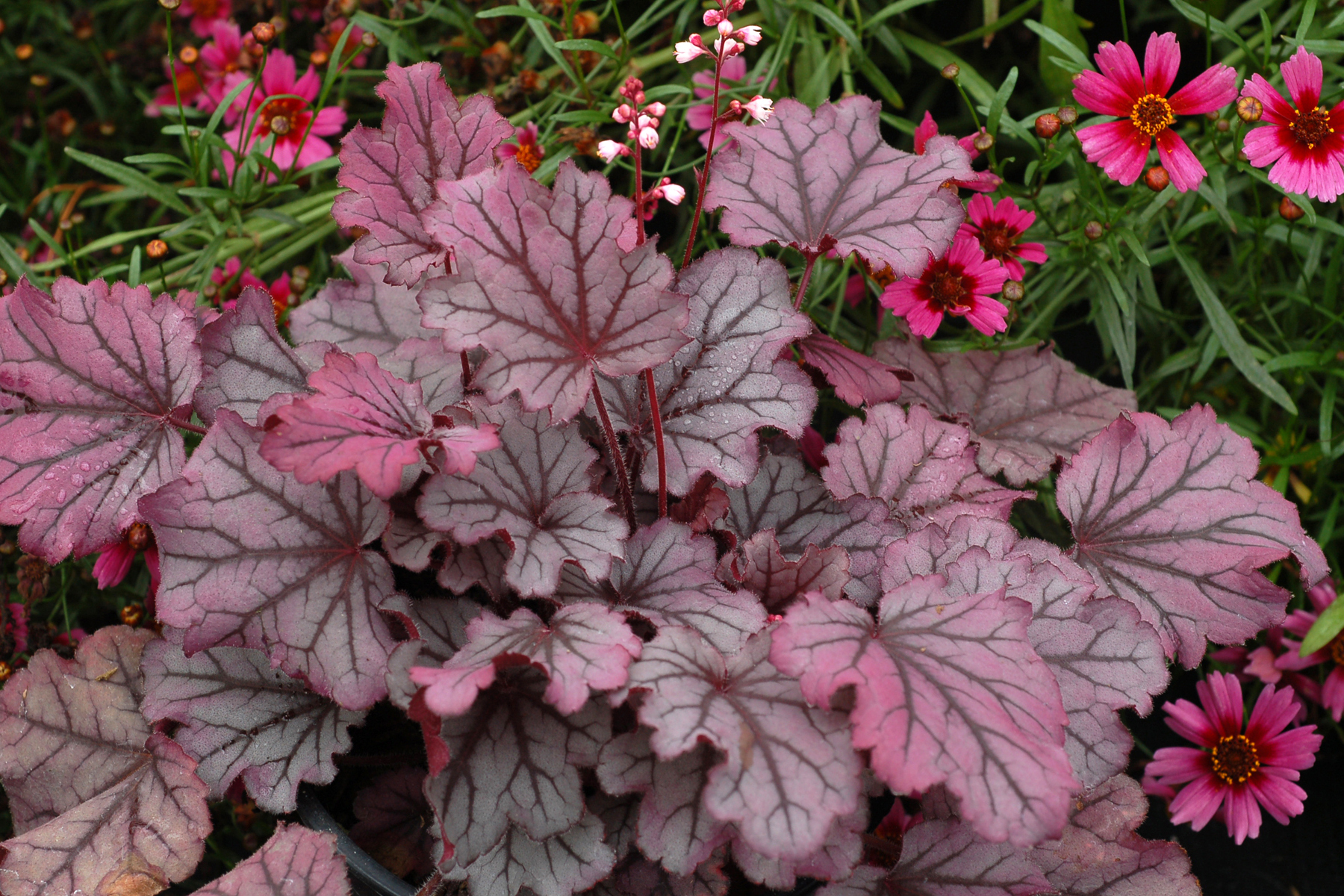
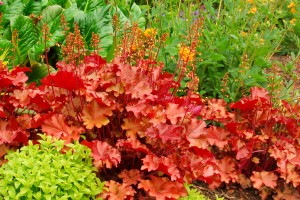
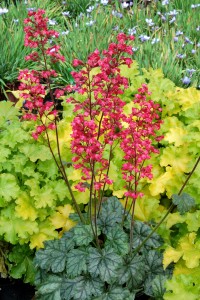
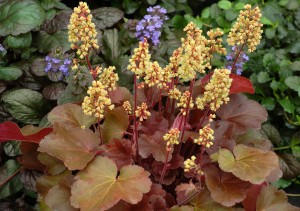
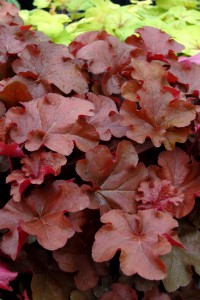
I, too, have noticed that the thinness of the leaves seem to correlate with less vigor and health. One of my light-leaved faves though is 'Caramel,' and it seems to hold up quite nicely here in the southern half of Iowa (Zone 5b).
I love the color changes of Caramel Anne – good to know how it does in Iowa. Thanks
One of my favorite plant groups bar none. I have a penchant every spring to try a new one. I have learned VERY quickly who the hardiest team players are here at my house and I run with those!
Great post Karen!
You just like having an excuse to go plant shopping – and I happily oblige 🙂 Thanks Christina.
I'm in love with this plant group too. I just received my copy of your new book Fine Foliage and it also has lots of beautiful examples using these plants.
So glad you like our book Sidney! We'll have to see which of these treasures we can experiment with next year in your containers.
Ok it may sound heretical but I compost all plant material from my yard diseased or not. Fungal diseases are either soil borne or so easily spread just by disturbing the infected leaves which rapidly disperses the spores. The key, I believe, is interrupting the disease triangle (susceptible host, pathogen, environment). I believe the pathogen is always present so the only way to prevent disease is to plant a resistant host, and to alter the environment if possible. Eliminating diseased material in a closed environment like a greenhouse makes sense but not in the open garden. Kicking diseased plants to city compost or the landfill helps no one. Some years due to weather, disease will be worse than in other years. Sometimes too we as gardeners have to accept that we cannot grow a plant (for us in MI we face this issue with impatiens and downy mildew). Fortunately there are many other plants to know and grow!
Susan, experience is a valuable thing so if that is working for you, well done! I prefer not to take the chance especially as I know my compost does not reach high temperatures. I've no need to send anything to landfill though; infected material can decompose out of harms way in brush piles at the edge f our 5 acres well away from any planting beds.
Rust has not been a problem on my heucheras but many Terra Nova heucheras are not suited to the climate on the east coast. I am not sure if your readership is mostly from the PNW, but if it is from across the country then warnings need to be given. For example, Georgia Peach does not grow in the mid-Atlantic.
Carolyn, we are careful to note in all of our literature what plants are more suited for hot and humid areas. We are the only company that KNOWS and displays the heritage of our plants. We sample out plants out to many botanic gardens and Garden Writers specifically for performance feedback. Many plants did well at Mt. Cuba in Delaware – one of the largest test sites for Heuchera. I suggest you contact them for the results of their trials. To wave your hand and say anybody's plants are poor for a geographic area is short sighted IMHO. P. S. I was in St. Louis a week ago in an area with cold temps and very high summer humidity. H. 'Georgia Peach' (and H. 'Southern Comfort' ) actually were 2 of the best performers. Remember that poor drainage and clay soil are the biggest killers of Heuchera.
I was not criticizing your plants but instead pointing out that some heucheras don't work in the east, which I think you would be the first to admit. I really appreciate the guidance in your catalogue on the parentage of the plants and their suitability for different climates, which allows me to select only the ones with eastern parents and or heat resistance when I order from you. However, not everyone knows about this information and not all retail nurseries use it when buying plants from wholesalers so it is important for gardeners to know that they need to do research before they choose a heuchera. Karen has highlighted some beautiful plants in her post but some are probably not good for my climate.
Carolyn, my readership in international as I'm sure is yours and one of the wonderful things of a garden blogging community is to be able to share insights with one another based on good science, knowledge and experience. Your feedback on which Heuchera do/don't do well is interesting – as is Dan's comment (thank you Dan for taking time to share). Both should prove helpful to readers. The REALLY good news is that I have provided a resource for homeowners to get more in-depth information should they want it.
Hi Karen,
I'll share my top four Heuchera for disease resistancy without comprimising the esthetic appeal of these lovely Coral Bells. Dark Purple – Heuchera 'Obsidian'. Gold/Burgundy – Heuchera 'Marmalade'. Silver/Plum – Heuchera 'Sugar Plum'. Last but certainly not least, Bright Green – Heuchera 'Lime Ricky'. If 'Lime Ricky' has proven to have less success in your gardens than mine I would then recommend Heuchera 'Amber Waves' – it's has some of the highlighted greens that makes 'Lime Ricky' so attractive. I've had great success gardening with these varieties here in Ontario, Canada and Sheridan Nurseries continues to grow these specimens with high levels of success.
Hope this helps!
Really helpful feedback Sean – thank you
I live in the center of Long Island NY– I think its zoned 7b.. winters are cold and summers hot upwards to 102 for days. it can get humid too. whenever I read about what should work and what does are rarely the same unless its at dome nursery… I have Purple Palace ( can't beat it)and Melting Fine (struggling but still going on). I just drool over all these new ones but wondering which one to take a chance on. I have containers, covered patio.. under a tree..I would be willing to listen to your great advise!!
Thank You!
Hi Blue Angel – so glad you stopped by! the great news for you is that you CAN get good, solid, local advice to help you choose. Read the comment above from Dan Heims himself about the Mt. Cuba trial gardens in Delaware. They have a great website too. http://www.mtcubacenter.org/horticultural-research/trial-garden-research/
Dan also mentioned above that Georgia Peach and Southern Comfort were two of the best performers in St. Louis which has similar conditions to you. Hope this helps.
My problem with heucheras is that dreaded root weevil. Some varieties seem immune or perhaps the weevils didn't lay eggs near them. 'Paris,' 'Green Spice' and 'Beauty of Color' do quite well. The rest: toast. Great post!
Grace – a common problem. This link is great for ways to deal with that; http://www.plantagogo.com/acatalog/Growing_Tips___Information.html
I am like most gardeners and adore Heucheras. However, here in the Midwest, they detest our areas of clay soils, poor winter drainage and winter periods with no snow cover. The rabbits, possibly our most damaging "varmint" favor them over all other plants in early spring and mow them to the ground. They heave and must be reset every so often. Our have extremes of high heat and humidity in the summer and freezing cold with no humidity in winter. Because of the summer heat and humidity, they fare better with light shade but our shade tends to be very dry and not evenly moist compost that they prefer. They "melt" for us, in fact I wrote a published article called "Heuchera: the Midwest Shrinking Violet" and everyone knows what I mean without explanation. Much of this is due to the species used in hybridization not being our native richarsonii and americana; there are cultivars coming with those bloodlines that will help our area of the country. We are considering them short-lived perennials, much like Lobelia – that way we aren't disappointed if they last only 4-5 years and happy if they go longer. The cultivars mentioned are relatively new – we don't consider any plants here as having passed the test of time until they have gone 6 years or so – we thought the villosa hybrids were going to be the answer and 6 years or so down the line even they are melting for us. So when we talk durable, it is older cultivars like 'Dale's Selection', 'Amethyst Mist', 'Cappuccino', 'Crimson Curls', 'Marmalade', and others that fall on the list. For as common as 'Palace Purple' became, I have seen it growing in gravel in full sun as large as a shrub here. The newer xHeucherella crosses are doing very well for us, they tolerate tougher dry shade better than the Tiarella and seem more robust that Heuchera. It won't include the explosion of new cultivars, but one of the best evaluations of Heuchera, particularly for we in the Midwest is the one done by Richard Hawke at Chicago Botanic Garden. Should work for you folks in the East as well http://www.chicagobotanic.org/downloads/planteval_notes/no21_coralbells.pdf. Again, I am not knocking the plant, I still try lots of the new ones but they have issues in the Midwest that if we don't educate our public about, they will get disappointed quickly and move on to other perennials.
Great, helpful feedback Ed, although I believe in fact the americana species has in fact been used for some time (although it is not a species I am personally familiar with).
Hi Karen, So far, I haven't had much problem with my Heuchera when it comes to disease. Knock on wood. I will keep some of the preventative tips in mind. I have always wondered about the difference between Heucherella (foamy bells) and Heuchera (coral bells). I know the leaves are a bit different and the flowers are not exactly alike, but they are similar. Are they botanical cousins?
Hi Jen, Heucherella are a cross between Heuchera and Tiarella
"Delicious as a summer dessert" — that is so true of 'Sugar Berry'! Based on what Ed said, I'm starting to understand why I've had a bit of a struggle with Heuchera. In my previous, more sunny garden, though, they seemed to thrive when planted in the light shade near the house. Here in my shady garden I haven't had any luck with them. I see healthy ones around town, though, so maybe I just haven't found a good spot for them. You have showcased some stunning varieties here. Thank you!
I love it when we can pass on tips to one another! For my part, if I fail in the ground because of say vine weevils I know I'll have good results in containers. My biggest issue is the deer which are strolling through my garden as I write this! I'm excited to know that deer seem less interested in Tiarellas – now all I need are sun loving Tiarella and I'll be set!
Maybe try some of the Heucherella in this garden Plant Postings?
I LOVE this plant, but have ceased to use it in customer's yards, as it rarely survives. Even in heavily amended soil (lots of compost into heavy clay) and strict shade planting, by mid-summer it just disappears, frequently forever. I love both the purple and lime varieties, but have taken to using purple oxalis, and lemon coral sedum instead, as they seem to thrive in the same spots. I'd love to use more heuchara in Texas (outside Dallas) if someone can tell me how to keep them alive!
Nancy, I'd recommend contacting Jimmy Turner at the Dallas Arboretum (LOVE that place!) and ask him for recommendations. Dan Heims thought that 'Southern Comfort' should do well for you as well as many of the Heucherella especially 'Golden Zebra'.
I just stumbled onto your blog through a pin on Pinterest and really enjoyed this article on Heucheras. When I lived in England, I took a flower arranging class and fell in love with these plants. My eyes were opened to a new world of foliage, and I have not looked at plants the same way since! I have tried to plant these in my backyard on Cheyenne Mountain in Colorado Springs. Unfortunately, I can't report how well they grow here, as the deer ate them all! It's like they have little homing beacons that draw them in–so much for being deer resistant! I do have a shady place in my front yard that should be out of reach, so I will try again this year. I am also excited about your new book and plan to purchase it ASAP! Cheers!
Welcome! So glad you have found this blog and enjoy it. What part of England did you live in out of curiosity?
Yes the deer are my personal nemesis – I'm going to look for more Tiarellas for the wilder parts of my garden and try to hide these Heuchera closer to the house!
Hope you love Fine Foliage – you can purchase signed copies on this website and I also have links to Amazon etc.
I just looked at the preview of your book on Amazon and saw that you grew up in England! I lived in Norfolk–my husband was stationed for 3 years at RAF Lakenheath. We lived in the little village of Croxton, which was so small that it didn't have a pub! Thetford is the closest sizable town, where I used to do my shopping.
The woman who taught our flower-arranging class used to do the flowers for Sandringham, so I learned the formal style. She retired from teaching the military wives (she used to drive down from Norwich) just as I was leaving for the states. I was so fortunate to have taken her classes!
I am convinced that Brits just naturally have a green thumb! I was so excited by what I learned and saw in England that I started gardening after moving here to Colorado. It is definitely a different story, having to plant while being mindful of deer and the lack of rainfall (water restrictions are supposed to start in April). This year should be interesting!
I am also interested in learning where you grew up. I assume the climate in Washington is very much like that in Britain. I do enjoy the sunshine here, but would go back in a heartbeat, I miss it so!
Yes the WA climate is very similar to the UK. I grew up on the Wirral in the NW although my husband and I lived in the Peak District before moving her in 1996. Small world indeed!